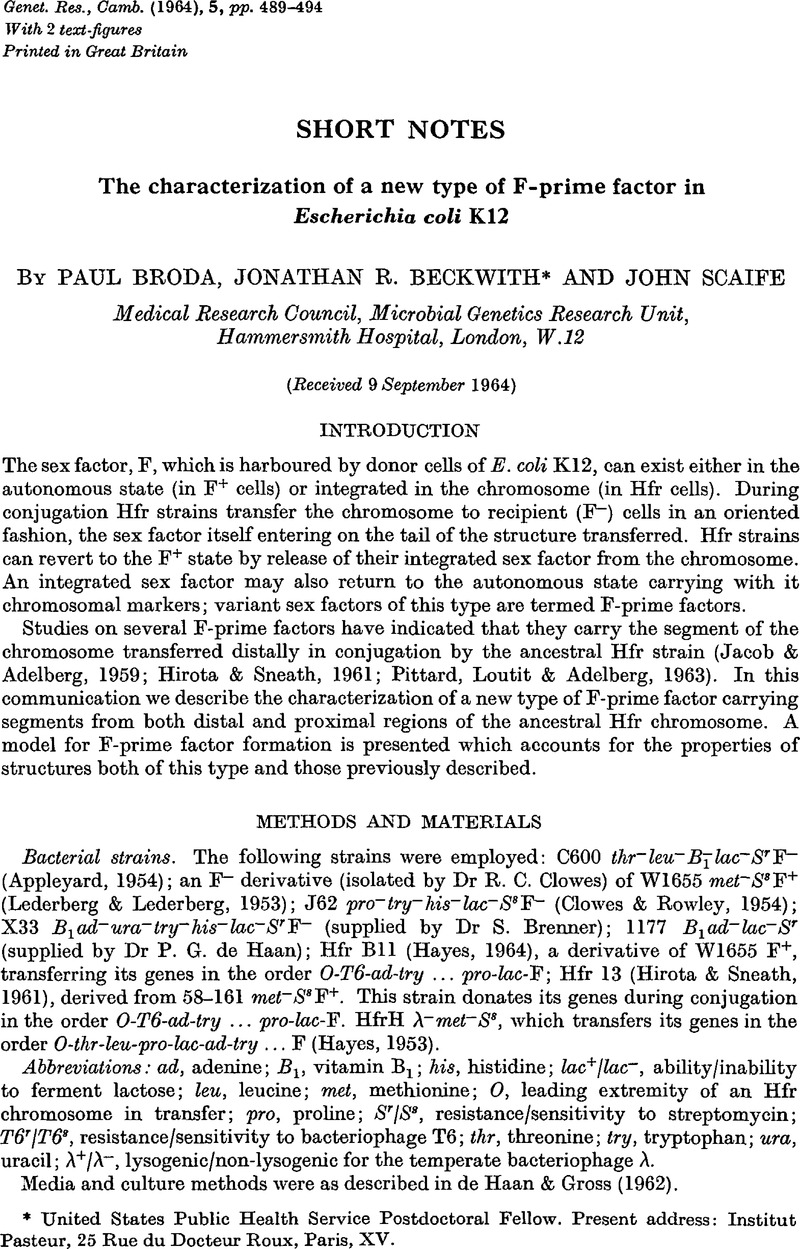Crossref Citations
This article has been cited by the following publications. This list is generated based on data provided by Crossref.
Scaife, John
and
Pekhov, A. P.
1964.
Deletion of chromosomal markers in association with F-prime factor formation inEscherichia coliK12.
Genetical Research,
Vol. 5,
Issue. 3,
p.
495.
Herman, Robert K.
1965.
Reciprocal Recombination of Chromosome and F-Merogenote in
Escherichia coli
.
Journal of Bacteriology,
Vol. 90,
Issue. 6,
p.
1664.
Gallant, J.
and
Spottswood, T.
1965.
Escape synthesis of alkaline phosphatase.
Biochimica et Biophysica Acta (BBA) - Nucleic Acids and Protein Synthesis,
Vol. 103,
Issue. 1,
p.
109.
Gross, Julian D.
and
Caro, Lucien
1965.
Genetic Transfer in Bacterial Mating.
Science,
Vol. 150,
Issue. 3704,
p.
1679.
Scaife, John
1966.
F-prime factor formation inE. coliK12.
Genetical Research,
Vol. 8,
Issue. 2,
p.
189.
Meynell, E
Meynell, G G
and
Datta, N
1968.
Phylogenetic relationships of drug-resistance factors and other transmissible bacterial plasmids.
Bacteriological Reviews,
Vol. 32,
Issue. 1,
p.
55.
Richmond, M.H.
1968.
Advances in Microbial Physiology Volume 2.
Vol. 2,
Issue. ,
p.
43.
Richmond, M. H.
and
Johnston, Joan
1969.
The reversible transition of certain genes inStaphylococcus aureusbetween the integrated and the extra-chromosomal state.
Genetical Research,
Vol. 13,
Issue. 3,
p.
267.
Broda, Paul
and
Meacock, Peter
1971.
Isolation and characterisation of Hfr strains from a recombination-deficient strain of Escherichia coli.
Molecular and General Genetics MGG,
Vol. 113,
Issue. 2,
p.
166.
Richmond, M. H.
1972.
A comparison of the exo-penicillinases mediated by a chromosomal gene in a strain of Staphylococcus aureus PS 80 and by a plasmid gene in Staphylococcus aureus 8325.
Genetical Research,
Vol. 19,
Issue. 2,
p.
187.
Low, K B
1972.
Escherichia coli K-12 F-prime factors, old and new.
Bacteriological Reviews,
Vol. 36,
Issue. 4,
p.
587.
Moody, Eric E. M.
and
Hayes, W.
1972.
Chromosome Transfer by Autonomous Transmissible Plasmids: the Role of the Bacterial Recombination (
rec
) System
.
Journal of Bacteriology,
Vol. 111,
Issue. 1,
p.
80.
Bachmann, B J
1972.
Pedigrees of some mutant strains of Escherichia coli K-12.
Bacteriological Reviews,
Vol. 36,
Issue. 4,
p.
525.
Moody, Eric E. M.
and
Runge, Richard
1972.
The integration of autonomous transmissible plasmids into the chromosome ofEscherichia coliK12.
Genetical Research,
Vol. 19,
Issue. 2,
p.
181.
Achtman, Mark
1973.
Current Topics in Microbiology and Immunology.
Vol. 60,
Issue. ,
p.
79.
Low, Brooks
1973.
Rapid Mapping of Conditional and Auxotrophic Mutations in
Escherichia coli
K-12
.
Journal of Bacteriology,
Vol. 113,
Issue. 2,
p.
798.
Hu, S
Ohtsubo, E
and
Davidson, N
1975.
Electron microscopic heteroduplex studies of sequence relations among plasmids of Escherichia coli: structure of F13 and related F-primes.
Journal of Bacteriology,
Vol. 122,
Issue. 2,
p.
749.
Kahn, Phyllis L.
and
Clement, Marilyn
1975.
Characterization of V-Prime Factors in
Escherichia coli
K-12
.
Journal of Bacteriology,
Vol. 124,
Issue. 1,
p.
589.
Hermann, M
Garg, G K
and
Gunsalus, I C
1979.
Fertility factors in Pseudomonas putida: selection and properties of high-frequency transfer and chromosome donors.
Journal of Bacteriology,
Vol. 137,
Issue. 1,
p.
28.
Hadley, R G
and
Deonier, R C
1979.
Specificity in formation of type II F' plasmids.
Journal of Bacteriology,
Vol. 139,
Issue. 3,
p.
961.





